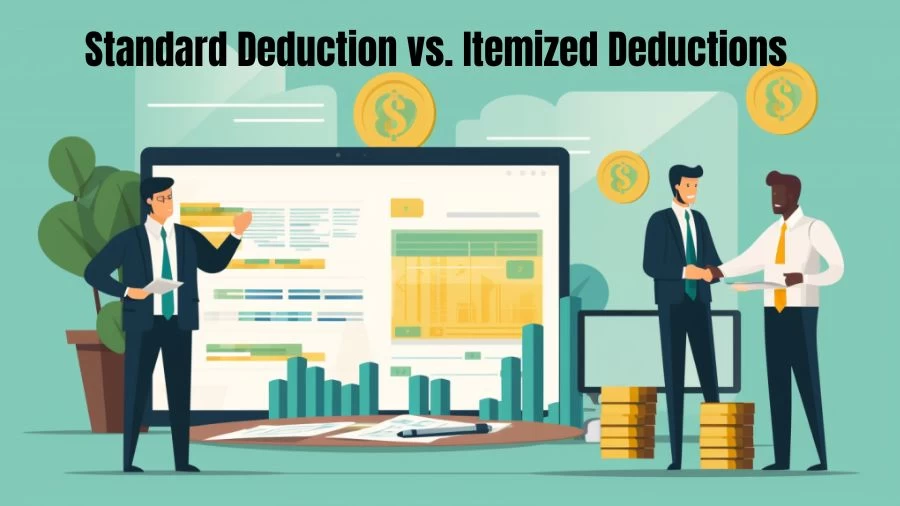
Standard Deduction Vs. Itemized Deductions, What Are the Advantages and Disadvantages of Itemized Deductions?
Standard deduction offers a fixed reduction in taxable income for all taxpayers, while itemized deductions require detailing eligible expenses, potentially leading to larger deductions but requiring meticulous record-keeping and documentation.
by Kowsalya
Published Aug 29, 2023 | Updated Aug 29, 2023 | 📖 13 min read
On This Page
- Standard Deduction Vs. Itemized Deductions
- What Are the Difference Between Standard Deductions and Itemized Deductions?
- What is Standard Deduction?
- What is Itemized Deduction?
- When to Choose the Standard Deductions and Itemized Deductions?
- How to Claim Itemized Deductions?
- What is the Standard Deduction for 2022?
- What is the Standard Deduction for 2023?
- What Are the Advantages and Disadvantages of Itemized Deductions?
- What Are the Advantages and Disadvantages of Standard Deductions?
Standard Deduction Vs. Itemized Deductions
When it comes to filing your taxes, one crucial decision you'll need to make is whether to take the standard deduction or itemize your deductions. Both options have their advantages, and choosing the right one can significantly impact the amount you owe or the refund you receive. Let's delve into the differences between standard and itemized deductions, helping you understand which strategy might be best for your financial situation.
Standard Deduction
The standard deduction is a fixed amount subtracted from your taxable income. It's a straightforward approach, available to all taxpayers, regardless of their specific expenses. The standard deduction varies based on your filing status, age, and other factors, and it's designed to provide a baseline reduction in your taxable income.
Itemized Deductions
Itemizing deductions involves listing and totaling eligible expenses you incurred throughout the tax year. This approach requires more effort, as you'll need to keep records of your expenses and ensure they qualify for deductions according to IRS guidelines. Eligible expenses can include things like mortgage interest, medical expenses, state and local taxes, and charitable contributions.
What Are the Difference Between Standard Deductions and Itemized Deductions?
When filing your tax return, one of the key decisions you must make is whether to claim the standard deduction or opt for itemized deductions. This choice can significantly impact your tax liability and determine the amount of tax you owe or the refund you'll receive. Let's delve into the details of both options to help you make an informed decision.
Standard Deduction:
The standard deduction is a predefined flat amount that reduces your taxable income. It varies based on your filing status, and for 2022 tax returns (filed in 2023), the standard deduction amounts are as follows:
- Single Taxpayers and Married Individuals Filing Separately: $12,950
- Heads of Household: $19,400
- Married Couples Filing Jointly or Qualifying Widow(er): $25,900
Additionally, taxpayers who are 65 years of age or older, as well as those who are blind, are eligible for even higher standard deductions. The IRS provides a worksheet in the Form 1040 instructions to help calculate the adjusted standard deduction for these individuals.
Claiming the standard deduction is straightforward and requires minimal record-keeping. You don't need to keep track of specific expenses or provide documentation like receipts or bills. It's an attractive option for those who have relatively simple financial situations and modest deductions.
Itemized Deductions:
Itemized deductions, on the other hand, involve detailing specific deductible expenses that you incurred throughout the tax year. These expenses can include:
- Medical Expenses: Including doctor's visits, prescriptions, and certain medical procedures.
- State and Local Taxes: Such as property taxes and either state income tax or sales tax (you can choose one or the other, but not both).
- Mortgage Interest: Interest paid on mortgages for qualified homes.
- Charitable Donations: Contributions made to qualified charitable organizations.
- Certain Miscellaneous Deductions: Such as unreimbursed employee business expenses and tax preparation fees.
If your total itemized deductions exceed the standard deduction for your filing status, it's generally beneficial to itemize. This is because itemizing can potentially reduce your taxable income by a larger amount, resulting in a lower tax liability. However, the trade-off is that itemizing requires meticulous record-keeping and documentation. You'll need to gather and present receipts, statements, and other supporting documents to substantiate your claimed deductions.
What is Standard Deduction?
The standard deduction constitutes a specific portion of an individual's income that remains exempt from taxation, thereby serving as a mechanism to effectively lower the overall tax liability. This deduction provides taxpayers with a means to reduce the amount of income that is subject to taxation, resulting in a diminished tax obligation.
To ensure that the standard deduction aligns with economic changes, the Internal Revenue Service (IRS) undertakes annual adjustments to account for inflation's impact. This iterative adjustment guarantees that the value of the standard deduction remains in sync with the evolving economic landscape.
The quantum of the standard deduction accessible to each taxpayer is contingent upon various factors. These encompass the individual's filing status, age, and an array of additional criteria that collectively determine the permissible extent of this deduction.
Within the tax realm, taxpayers are presented with the option of selecting either the standard deduction or opting for itemized deductions. This choice allows individuals to tailor their tax strategy according to their financial circumstances. The standard deduction provides a simplified route, offering a fixed deduction that obviates the necessity to meticulously track and document an exhaustive list of qualifying expenses.
As a result of its convenience and straightforwardness, a considerable proportion of taxpayers opt for the standard deduction. This is primarily attributed to the fact that it liberates individuals from the arduous task of monitoring and substantiating every conceivable qualifying expense. The standard deduction's appeal lies in its ability to provide tax relief without necessitating an extensive record-keeping process, thus streamlining the tax-filing experience for many.
What is Itemized Deduction?
Itemized deductions play a crucial role in facilitating certain taxpayers to significantly reduce their annual income tax liability, surpassing the benefits offered by the standard deduction. In the tax landscape, individuals are presented with a pivotal choice between itemized deductions and the standard deduction, with the crucial caveat that they cannot concurrently opt for both options. This selection dictates the path that taxpayers will take to optimize their tax obligations.
The realm of itemized deductions encompasses various categories that can prove advantageous to taxpayers seeking to curtail their tax bills. These categories encompass substantial aspects such as medical expenses, mortgage interest payments, and charitable contributions, which stand as key survivors in the itemized deduction realm. Additionally, other noteworthy categories encompass state income taxes, local income taxes, personal property taxes, and losses incurred due to disasters.
An essential tenet to grasp is that opting for itemized deductions entails a trade-off, as it necessitates meticulous record-keeping and the accumulation of relevant documentation to substantiate these deductions. This nuanced approach requires individuals to assemble comprehensive evidence that validates the claimed deductions, underscoring the intricate nature of itemizing.
When to Choose the Standard Deductions and Itemized Deductions?
Choosing the Standard Deduction:
- Simplicity: If your eligible itemized deductions are likely to be lower than the standard deduction amount, opting for the standard deduction is simpler and less time-consuming.
- Limited Deductible Expenses: If you're in a situation where you don't have many eligible expenses to itemize (e.g., you don't own a home, have significant medical expenses, or make sizable charitable donations), the standard deduction might be more advantageous.
- Time Constraints: If you're looking for a quick and hassle-free way to file your taxes, taking the standard deduction can expedite the process.
Choosing the Itemized Deductions:
- Higher Deductible Expenses: If your total eligible itemized deductions exceed the standard deduction amount, itemizing could lead to a lower taxable income and, consequently, a reduced tax bill or increased refund.
- Homeownership: If you own a home and your mortgage interest, property taxes, and other related expenses surpass the standard deduction, itemizing might provide substantial tax benefits.
- Significant Medical Expenses: If you've had substantial unreimbursed medical expenses that exceed a certain percentage of your income (7.5% in 2020), itemizing could help you get deductions for these costs.
- Charitable Contributions: If you've made sizable donations to qualified charitable organizations and these contributions are higher than the standard deduction, itemizing could be more advantageous.
Choosing whether to claim the standard deduction or itemize requires careful consideration of your financial situation. If your deductible expenses are close to the standard deduction threshold, it might be worthwhile to calculate both scenarios to determine which option provides the most tax savings.
In conclusion, the choice between standard deduction and itemized deductions hinges on the complexity of your financial situation and the amount of deductible expenses you have. While the standard deduction is simpler and doesn't require detailed documentation, itemizing can lead to substantial tax savings if your eligible expenses surpass the standard deduction threshold. It's recommended to consult with a tax professional or use tax preparation software to ensure you're maximizing your deductions and minimizing your tax liability.
How to Claim Itemized Deductions?
Determining whether to opt for itemized deductions is the initial stride in this tax choice. To make an informed decision, gather pertinent details regarding the categories highlighted earlier and juxtapose the potential amount you might itemize against the potential standard deduction. Below are the standard deduction thresholds by filing status for both 2022 and 2023.
2022 and 2023 Standard Deduction:
- Single: $12,950 (2022) / $13,850 (2023)
- Married Filing Jointly: $25,900 (2022) / $27,700 (2023)
- Married Filing Separately: $12,950 (2022) / $13,850 (2023)
- Head of Household: $19,400 (2022) / $20,800 (2023)
Should the cumulative sum of qualifying deductions surpass the aforementioned figures, the taxpayer is eligible to embark on itemizing deductions. This can be executed by inputting the pertinent details on Schedule A within the tax return.
The summation of all itemized deductions transpires within the form and subsequently migrates to the second page of Form 1040. Consequently, the sum total of itemized deductions is subtracted from the taxpayer's adjusted gross income, culminating in the taxpayer's taxable income. This intricate process facilitates a precise reflection of an individual's tax liability.
What is the Standard Deduction for 2022?
In the tax year 2022, the standard deduction amounts have been set at $12,950 for individuals filing as single or married filing separately. If you're a head of household, the standard deduction increases to $19,400.
For married couples filing jointly or qualifying widow(er) taxpayers, the standard deduction is $25,900. These fixed deduction figures provide a direct reduction in your taxable income, simplifying the filing process.
Opting for the standard deduction is a straightforward choice for those whose eligible itemized deductions are lower than these predetermined amounts. However, if you have substantial deductible expenses such as mortgage interest, medical costs, or charitable contributions that exceed these figures, itemizing deductions could be more financially advantageous. Carefully assess your specific circumstances to determine the best approach for optimizing your tax liability.
What is the Standard Deduction for 2023?
In the Tax Year 2023, the standard deduction amounts have been updated. If you file as single or married filing separately, the standard deduction is now $13,850. For individuals classified as heads of household, the standard deduction increases to $20,800. Married couples filing jointly or qualifying widow(er) taxpayers can avail a standard deduction of $27,700.
These standardized deduction values offer a direct reduction in your taxable income, streamlining the tax filing process. Opting for the standard deduction is recommended when your eligible itemized deductions fall below these preset amounts.
However, if you have considerable deductible expenditures such as mortgage interest, medical outlays, or charitable donations surpassing these values, considering itemized deductions might be more financially advantageous. It's important to thoroughly evaluate your unique financial situation to make an informed decision that optimally manages your tax liability.
What Are the Advantages and Disadvantages of Itemized Deductions?
Advantages of Itemized Deductions
Embracing itemized deductions offers several distinct advantages, enhancing the potential for tax savings by leveraging personalized deductions that may surpass the standard deduction. The cumulative effect of these deductions directly influences your tax liability, fostering a proactive approach to minimizing your tax payments. Individuals opt for itemization due to the prospect of surpassing the standard deduction with the sum total of their itemized deductions.
The realm of itemized deductions is expansive, encompassing numerous potential deductions authorized by the IRS. These deductions span a broad spectrum, including but not limited to medical expenses, property taxes, charitable contributions, and mortgage interest. These deductions resonate with a diverse range of taxpayers, reflecting their unique financial circumstances.
Certain scenarios accentuate the allure of itemization. Particularly, homeowners find itemized deductions appealing. In the case of homeownership, the cumulative deductions for mortgage interest and property taxes are often positioned to outstrip the standard deduction, culminating in tangible savings.
Disadvantages of Itemized Deductions
Despite their advantages, itemized deductions entail some inherent challenges. Understanding the nuanced rules associated with specific itemized deductions can prove intricate. For instance, the deduction for medical expenses necessitates that only the portion exceeding 7.5% of your adjusted gross income is eligible for deduction.
Another noteworthy drawback is the additional time investment required for tax preparation. Choosing to itemize obligates you to allocate extra time to complete comprehensive tax forms, including Form 1040 and Schedule A. Moreover, these complex forms are supplemented by supporting schedules, demanding meticulous attention to detail.
A fundamental requisite for itemizing deductions is the need for substantiation. In essence, this necessitates the organization and retention of accurate records that validate each deduction claimed. Adhering to this requirement mandates meticulous record-keeping and organizational skills. Transitioning from the standard deduction to itemization underscores the importance of safeguarding receipts and other forms of evidence to substantiate your deductions.
What Are the Advantages and Disadvantages of Standard Deductions?
Advantages of Standard Deductions:
- Simplicity: Claiming the standard deduction is straightforward and uncomplicated. Taxpayers do not need to gather and organize detailed records of various expenses, making the filing process quicker and easier.
- No Documentation Required: Unlike itemized deductions, the standard deduction does not require taxpayers to provide supporting documentation such as receipts and records of expenses.
- Universal Access: The standard deduction is available to all eligible taxpayers, regardless of their financial situation or specific expenses. It serves as a baseline deduction that everyone can utilize.
- No Thresholds: Unlike some itemized deductions that have income-based limitations or thresholds, the standard deduction is accessible without any income-related restrictions.
- Suitable for Simple Finances: Individuals with relatively uncomplicated financial situations who don't have substantial qualifying expenses often find the standard deduction to be a suitable and hassle-free option.
Disadvantages of Standard Deductions:
- Potentially Lower Deduction: In some cases, the standard deduction amount might be lower than the total of eligible itemized deductions. This means taxpayers might miss out on potential tax savings if their qualifying expenses exceed the standard deduction.
- Limited Personalization: The standard deduction is a fixed amount that doesn't take into account an individual's specific financial circumstances, such as high medical expenses or substantial charitable donations.
- Missed Opportunities: Taxpayers who could potentially benefit from itemized deductions, especially if they have significant eligible expenses, might miss out on larger tax savings by opting for the standard deduction.
- Changing Tax Laws: Changes in tax laws and regulations can impact the value of the standard deduction from year to year, affecting taxpayers' potential savings.
- Lack of Flexibility: The standard deduction does not account for individual differences in expenses or regional variations in costs of living.
Standard Deduction Vs. Itemized Deductions - FAQs
1. What is the standard deduction, and who can claim it?
The standard deduction is a predetermined amount that reduces your taxable income. All taxpayers are eligible for it, regardless of specific expenses.
2. What are itemized deductions, and when should I consider using them?
Itemized deductions involve listing and totaling eligible expenses such as mortgage interest, medical costs, and charitable contributions.
3. Which option is simpler: standard deduction or itemized deductions?
The standard deduction is simpler as it offers a fixed reduction in taxable income without requiring detailed record-keeping.
4. How do I know if I should itemize deductions?
If you own a home with significant mortgage interest and property taxes, have substantial medical expenses, or make sizable charitable donations, itemizing might be advantageous.
5. Can I switch between standard and itemized deductions every year?
Yes, you can choose the deduction method that benefits you most each tax year. While some taxpayers consistently benefit from one method, others may find it beneficial to switch based on changing financial circumstances.




